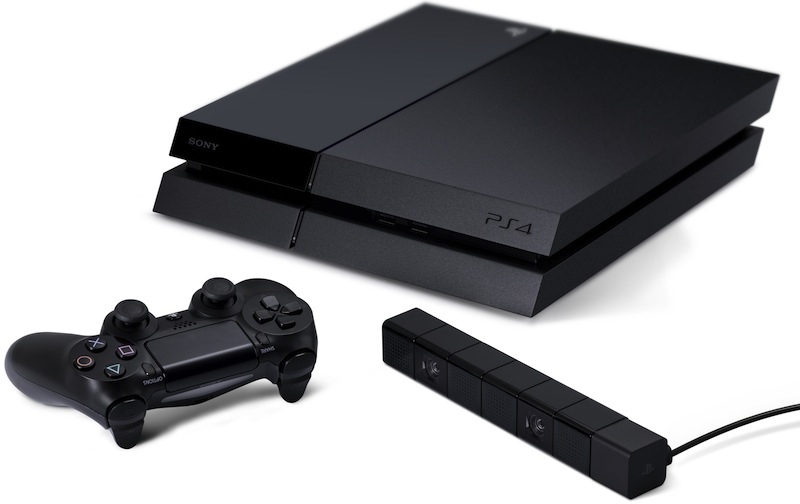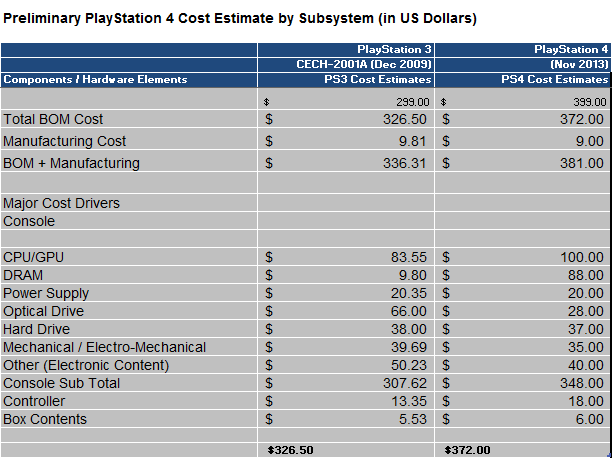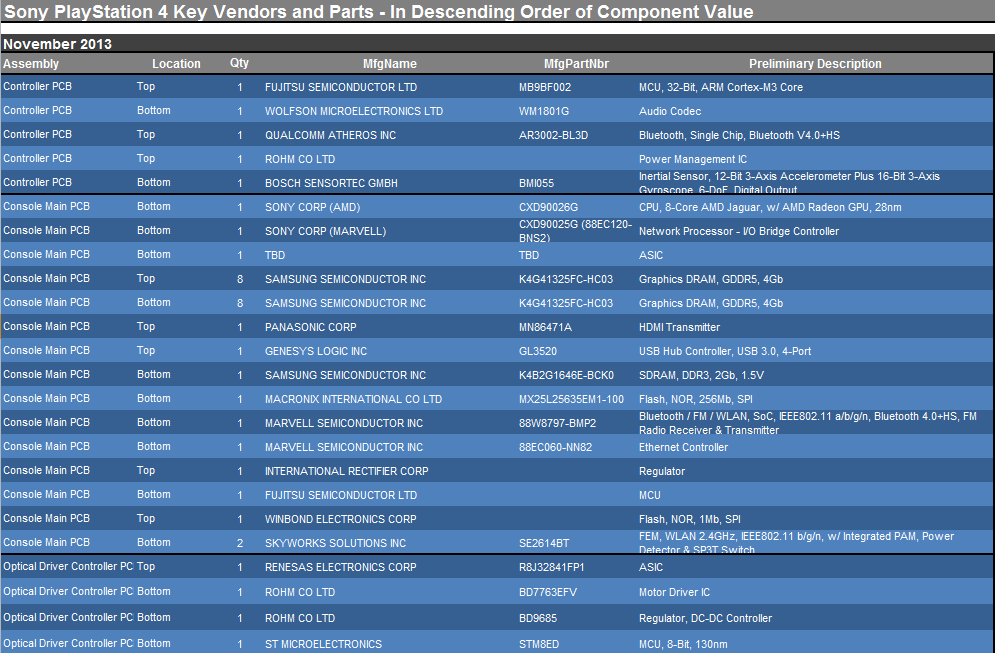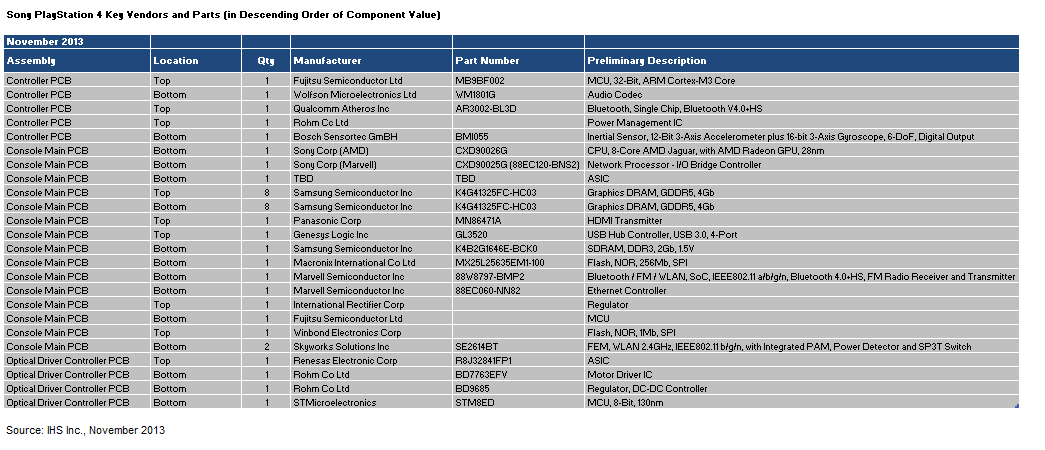 IHS announced that its preliminary estimates put the total cost of manufacture for Sony’s new PlayStation 4 (PS4) video game console at $381.
IHS announced that its preliminary estimates put the total cost of manufacture for Sony’s new PlayStation 4 (PS4) video game console at $381.
For more information visit: www.ihs.com
Unedited press release follows:
 Sony Nears Breakeven Point on PlayStation 4 Hardware Costs
Sony Nears Breakeven Point on PlayStation 4 Hardware Costs
El Segundo, Calif. (Nov. 19, 2013) — For the past seven years, Sony Corp. has offered various revisions of the PlayStation 3 console, many of which were sold at a loss.
However, with the new PlayStation 4, Sony has produced a design whose component and manufacturing costs are starting out lower than its price tag—paving the way for the company to quickly attain profitability on hardware sales, according to preliminary results from the Teardown Analysis Service at IHS Inc. (NYSE: IHS). Furthermore, the PlayStation 4 delivers major upgrades where it counts, with a processor and memory subsystem that pushes the envelope in terms of performance and product design.
The bill of materials (BOM) for the PlayStation 4 amounts to $372. When the manufacturing expense is added in, the cost increases to $381. This comes in $18 lower than the $399 retail price of the console.
When other expenses are tallied, Sony initially will still take a loss on each console sold. But the relatively low BOM of the PlayStation 4 will allow the company to break even or attain profitability in the future as the hardware costs undergo normal declines.
“When Sony rolled out the original model of the PlayStation 3 in 2006, our teardown analysis revealed that the console delivered supercomputer-class performance at a price equivalent to a notebook PC,” said Andrew Rassweiler, senior director, cost benchmarking services for IHS. “However, this achievement came with a major downside for Sony, as the BOM costs for most of the different versions of the console were in excess of the retail prices, in some cases by more than $100. Although Sony brought the PlayStation 3’s costs down significantly during its lifetime, the company’s intent was never to make money on the hardware, but rather to profit through sales of games and content.”
“This time, Sony is on a greatly shortened path to the hardware break-even point, or even profitability, with its cost-conscious PlayStation 4 design. The company is pulling off this feat, despite offering a brand-new design that once again includes avant-garde components that yield superfast performance. The PlayStation 4 keeps a lid on costs by focusing all the additional expense on the processor and memory—and reducing outlays for the optical drive, the hard disk drive (HDD) and other subsystems,” Rassweiler noted.
The PlayStation 4 is more economical for Sony than even the revision of the PlayStation 3 torn down by IHS, which was shipped in 2009, a model dubbed the CECH-2001A. That version of the PlayStation 3 carried a $336 BOM and manufacturing cost compared to a $299 sales price.
Table 1 attached presents the preliminary BOM and manufacturing cost estimate of the PlayStation 4. Note that the teardown assessment is preliminary in nature, accounts only for hardware and manufacturing costs, and does not include other expenses such as software, licensing, royalties or other expenditures.
Big money/big chip
The costliest subsystems in the PlayStation 4 are the core processor and the associated graphic dynamic random access memory (DRAM), which together entail $188—representing slightly more than 50 percent of the BOM of the entire console. This compares to only 29 percent for the fourth-generation PlayStation 3.
For the PlayStation 4, Sony clearly has integrated two functions—the core central processing unit (CPU) and graphics processing unit (GPU)–that were previously two discrete ICs.
“Sony clearly has made the decision to focus on balancing the brains and economics of the console, with the processor and memory dominating both the design and the BOM,” said Jordan Selburn, senior principal analyst for consumer platforms at IHS. “This processor is a monster, with the surface area of the chip amounting to about 350 square millimeters. That is three times larger than any other chip manufactured using equivalent-process technology that has been examined by the IHS Teardown Analysis service. Despite the remarkable silicon acreage of this device, it comes at a price point attractive to mainstream consumers while delivering a very high level of performance. Future versions, manufactured with even more advanced semiconductor processing technology, will further enhance both cost and performance.”
The processor exhibits a high degree of integration, using advanced 28-nanometer semiconductor manufacturing, and combining both the CPU and GPU into a single device. The Advanced Micro Devices Inc. processor includes an eight-core Jaguar CPU and a Radeon GPU. This processor costs $100.00, IHS estimates, compared to an $83.55 combined total for the two prior, equivalent integrated circuits from IBM and Nvidia that were used in the PlayStation 3 that IHS analyzed in 2009.
Precious memory
The cost increase for the DRAM is even more remarkable, at an estimated $88.00, up from just $9.80 for the fourth-generation PlayStation 3, i.e. the CECH-2001A. Note that the $9.80 total does not include the DRAM that was mounted directly to the Nvidia processor in the PlayStation 3 that IHS analyzed in 2009. This cost increase is due to the PlayStation 4’s adoption of advanced Graphics DRAM (GDRAM) GDDR5.
“GDRAM DDR5 memory has much higher bandwidth than the DDR3 used in the Xbox One. It also works better with parallel computing and is designed specifically to enhance graphics performance,” said Mike Howard, senior principal analyst, DRAM & memory, for IHS. “Because of its cutting-edge status, GDRAM GDDR5 is more expensive than DDR3, which is used in high volume in products including PCs and older game consoles.”
Cost cuts
Offsetting the increased costs for the processor and memory are unchanged or lower expenses for other subsystems.
The biggest area of cost reduction is in the optical drive, at only $28, compared to $66 for the CECH-2001A PlayStation 3. With the optical drive mechanism remaining largely unchanged since 2009, Sony was able to capitalize on the dramatic price erosion in this product during the past four years.
Sony trimmed another $10 from the BOM by using a more integrated design overall for the PlayStation 4. The design allowed Sony to reduce the number of small-sized integrated circuits, discrete semiconductors and passive components. The total cost of these devices amounted to $40.00 in the PlayStation 4, down from $50.23 in the CECH-2001A PlayStation 3 ().
Another $5 reduction was achieved in the mechanical portion of the design, including enclosures—like plastics and metals–and in the electro-mechanical content, such as printed circuit boards, connectors and wire harnesses.
More bang for the buck
The hard disk drive in the PlayStation 4 is $1 cheaper than the one in the CECH-2001A PlayStation 3, despite a major jump in capacity to 500 gigabytes (GB), up from 120 GB. This cost reduction reflected the major decline in HDD costs during the past four years.
Table 2 attached presents a summary of major components and their suppliers for the PlayStation 4.
About IHS (www.ihs.com)
IHS (NYSE: IHS) is the leading source of information, insight and analytics in critical areas that shape today’s business landscape. Businesses and governments in more than 165 countries around the globe rely on the comprehensive content, expert independent analysis and flexible delivery methods of IHS to make high-impact decisions and develop strategies with speed and confidence. IHS has been in business since 1959 and became a publicly traded company on the New York Stock Exchange in 2005. Headquartered in Englewood, Colorado, USA, IHS is committed to sustainable, profitable growth and employs approximately 8,000 people in 31 countries around the world.


